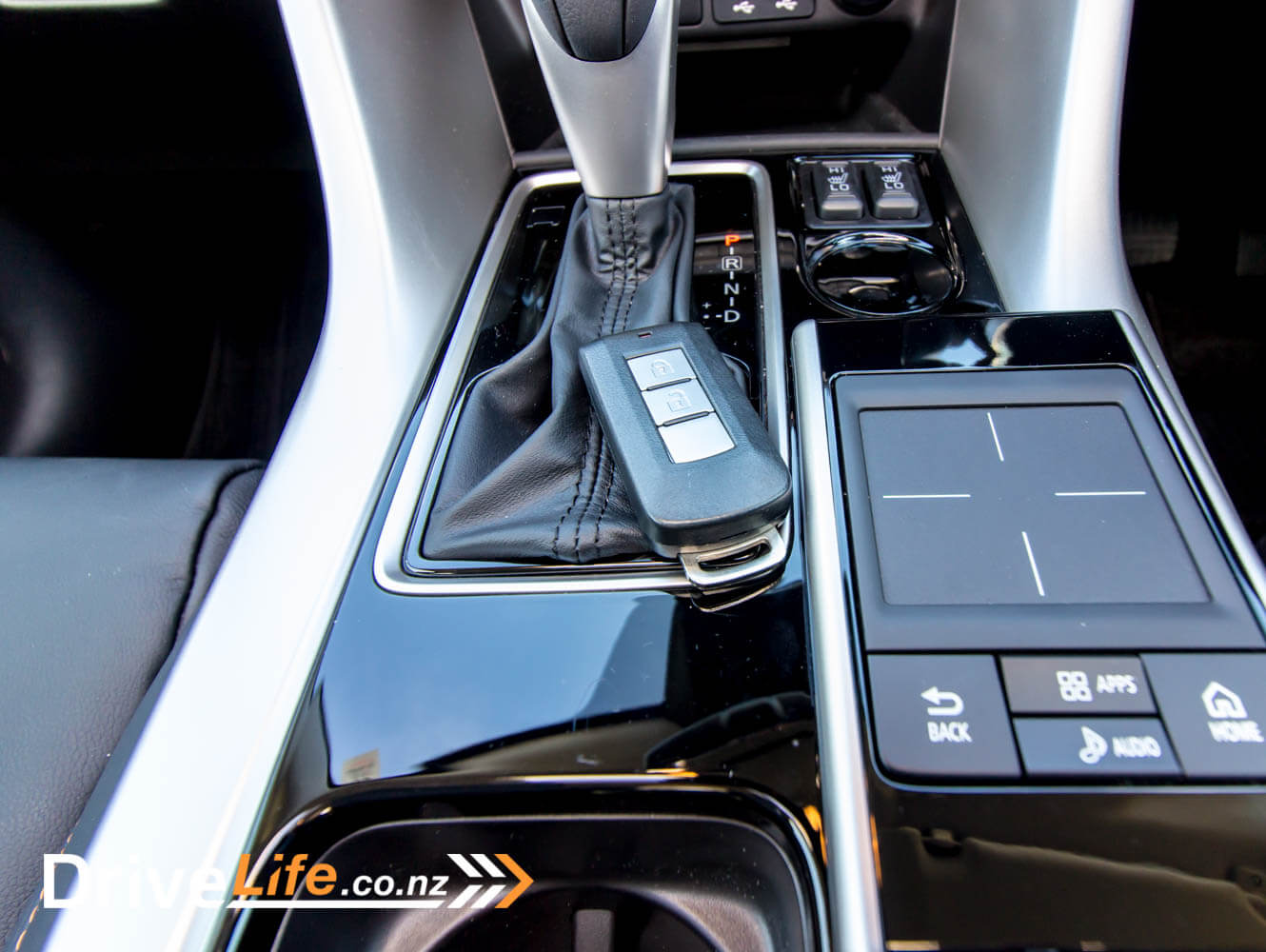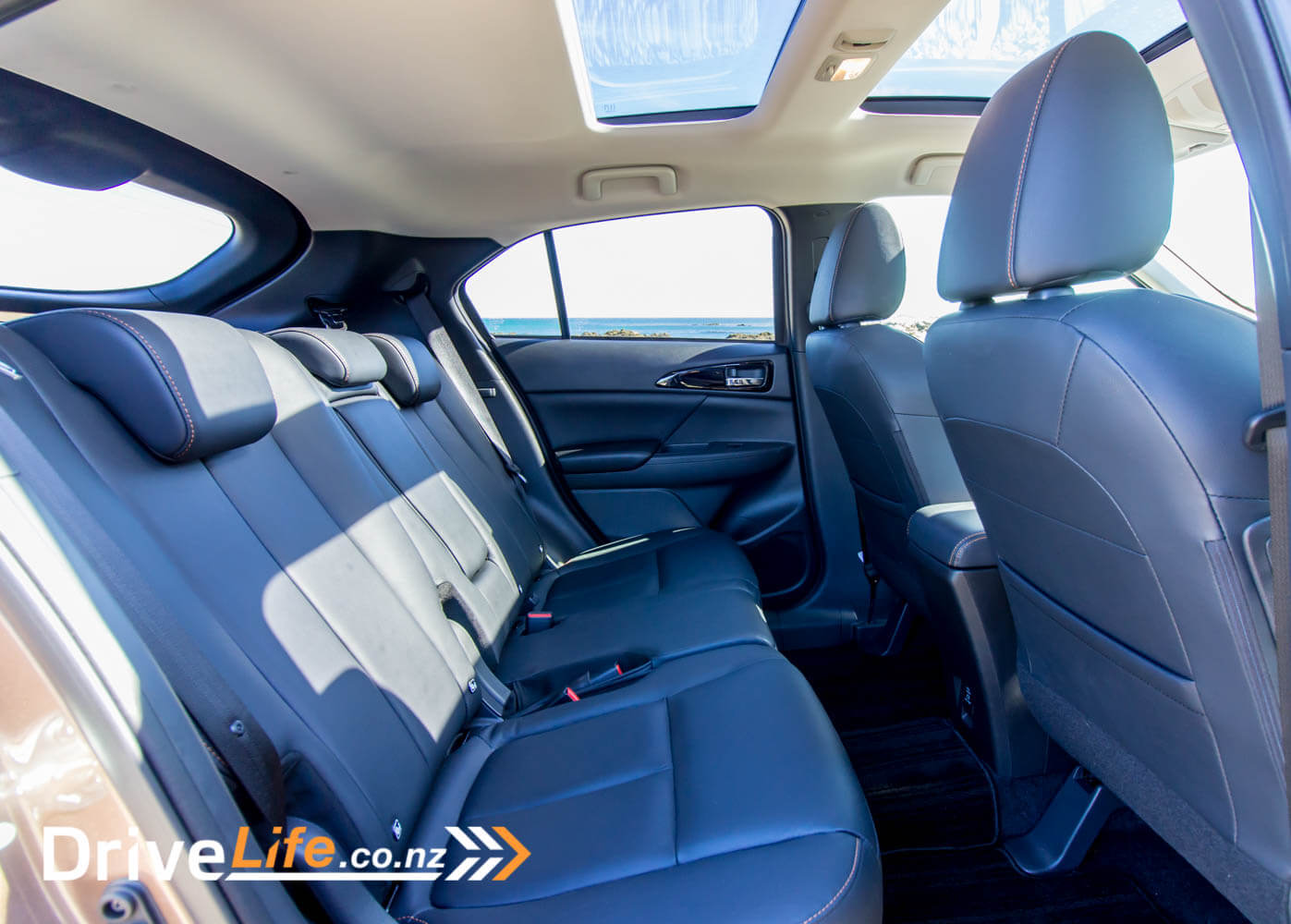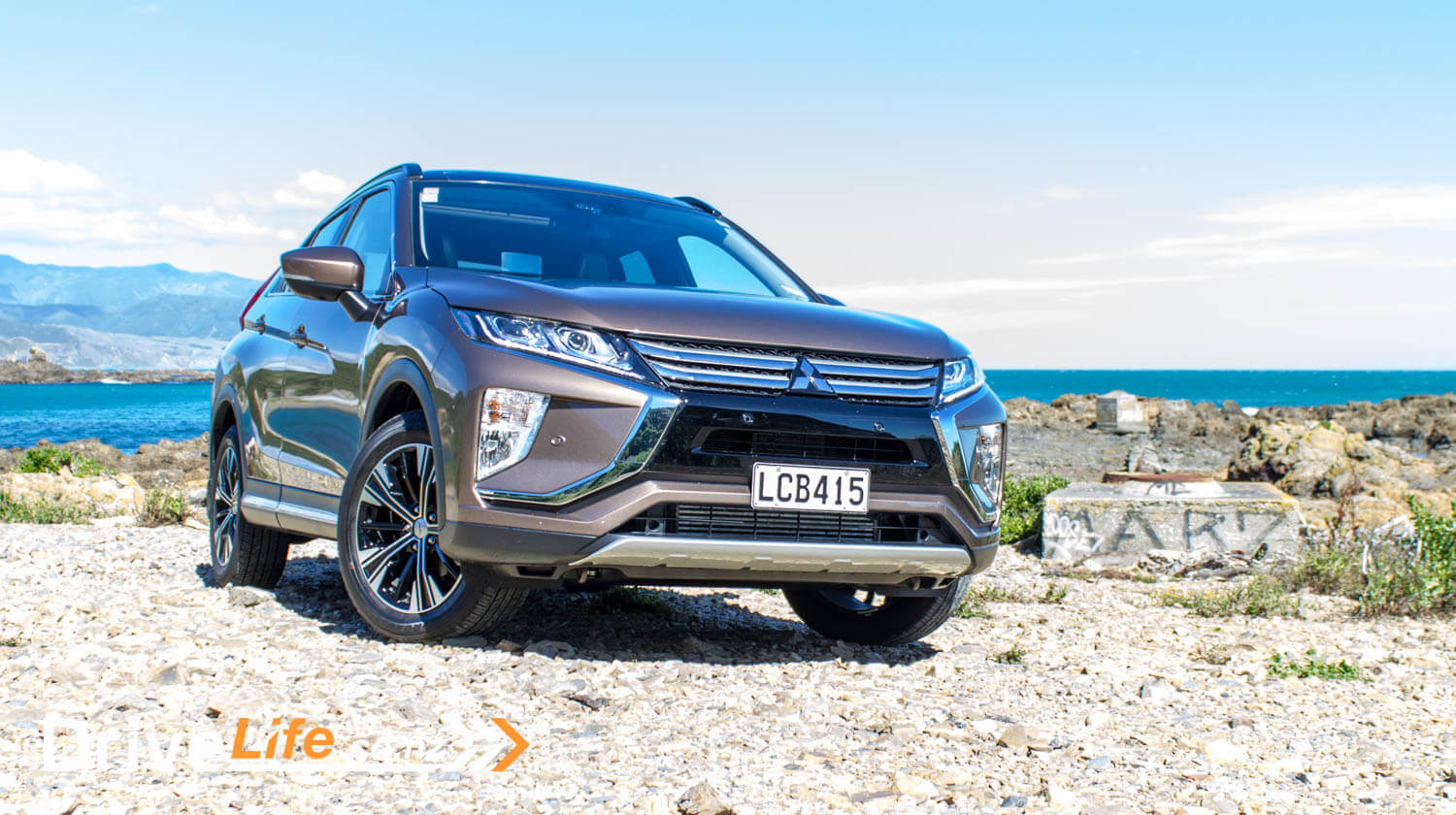Sitting in between the ASX and the Outlander comes Mitsubishi’s new Eclipse Cross. We’ve all seen the ads on TV – this is something Mitsubishi does well.
Can the Eclipse Cross live up to the TV hype?

The Range
Currently there’s just two models in the range, the XLS and the VRX (tested), and both front-wheel drive. The base XLS is priced at $41,690 and the VRX at $45,590. The TV adds show the pricing starting at $34,990 but this was a December special. I’m not sure if that pricing has carried on or not. Mitsubishi’s New Zealand website still shows a ‘Special Offer’ of $34,990.
Both models are fitted with a 1.5-litre, four-cylinder turbo petrol motor, putting out 122Kw of power and a good 254Nm of torque. Both are also fitted with the same transmission – a CVT with an 8-speed stepped mode.
On the safety side of things, Forward Collision Mitigation with windscreen-mounted laser and camera, Lane Departure Warning, Auto High Beam, Rain-Sensing Wipers and Dusk-Sensing Headlights all come as standard. The VRX adds radar functionality plus Adaptive Cruise Control, Blind Spot Warning (with Lane Change Assist), Rear Cross Traffic Alert and a Multi-Around View Monitor.
Also standard over both models are 18” alloys, privacy glass, LED tail lights, LED DRLs, front fog lamps, heated and power folding rear view mirrors, roof rails, keyless entry and start, electric park brake with auto-hold, paddle shifters, a 6-speaker audio system with 2x9cm mid-tweeters, adjustable speed limiter, climate control AC,
The VRX adds LED headlamps, a pop-up Heads-Up Display (HUD), heated front seats, power driver’s seat, front and rear parking sensors, dual-zone AC, and an auto-dimming rear-view mirror.
April this year will see the release of the AWD Eclipse Cross, which will carry a very-reasonable $2,000 premium over the FWD models.

First Impressions
There’s not many that can say the Eclipse is not eye-catching. While looking exactly the same as the Outlander at the front, it does catch your eye for sure. Is it attractive? That’s an individual choice. The Eclipse grew on me over the week, and it was certainly easy to spot it in a car park. I got some comments from people along the lines of, “is this the one from the TV ad?” Advertising works it seems.
Some of that may have to do with our test car’s colour, a light Mocca, which looked stunning in the right light.
I need you to sit down for Mitsubishi’s description of the front of the car – and don’t hold any hot drinks while you read this. Mitsubishi say it has an “Advanced Dynamic Shield Face with Chrome Trim and Grill”. Who knew?
There’s some nice sculpting on the sides of the car, and the rear is another eye-catcher; that split window isn’t something we see a lot of. I was asked more than once if it restricts rear visibility much, and it doesn’t – you get used to it very quickly. It does make for good low-down visibility too, from the driver’s seat. The rear taillights are distinctive to say the least.

The Inside
Being the VRX model, there’s lashings of black leather with contrasting orange stitching, which is always a nice touch. One of the first things to grab your eye on the inside is the amount of silver plastic used – especially on the centre console, and just above it. Very futuristic, and very much in your face. Still, it’s different to what we normally see.
There’s also quite a bit of piano black trim, which contrasts nicely with the silver. As always though, piano black attracts finger prints like nothing else.
A not-so-common feature on the Eclipse is the touchpad controller – Mitsubishi call it the ‘Touchpad Commander’. I generally see these as a bit of a gimmick and prefer a central dial, but this one works quite well. An added bonus is that you can use the touchpad to control your iPhone via phone projection (Apple CarPlay). Sorry Android users, you don’t get this feature.

I found the touchpad a bit quick to the touch, but after adjusting the settings it worked perfectly for me. Down by the touchpad are some buttons, Home, Apps, Audio, Back. The apps button only brings up the Apple CarPlay or Android Auto screens, so you have to have your phone connected by a cable for the Apps button to do anything. Also be aware that if you have a battery case (like I do) then CarPlay won’t work, you need to remove the phone from the case to plug it into the car. I’m sure it works just fine with a normal phone case, but battery case users will have to do this to use Apple CarPlay.
The button placement is nice though, and after a few days I didn’t need to look down to see what I was pressing.
Just ahead of the touchpad is a throwback to the 1980s: the VRX comes with heated front seats, and I think they went to the parts bin from a car decades ago for the buttons for this. You have this futuristic looking car with a futuristic touchpad, and then seat-heat buttons from an old Galant or something. They look terrible.

But you do get two sunroofs. Interesting that Mitsubishi have not bothered with a panoramic sunroof, instead going for a tilt/slide front sunroof and fixed rear sunroof. But have their own electric blinds to keep that pesky daylight out.
There’s no volume button for the audio, which is a shame – it’s either steering wheel controls, or touch controls on the screen. Mazda and a few other manufacturers have it all over the Eclipse here – having a separate volume knob is well worth it.
The main touchscreen display is 7”, and Mitsubishi have gone for the tacked-on look, instead of integrating it. It’s a nice clear display though, and usability is simple.

Sitting in the driver’s seat, you have a variety of displays to flick through, including A and B trip meters, fuel consumption and the Eco Tree. I’m not sure if that’s what it’s called, but it’s what I call it. The tree starts off with no leaves when the car is cold, and depending on your driving habits, you either grow leaves or lose them. It was hard to get it to have all the leaves (5) and keeping it at 4 leaves was an art in smooth driving.

While this is a top-spec car in the range, and is relatively well kitted out, you don’t get ventilated seats, driver’s lumbar adjustment or Qi wireless phone charging.
Rear legroom is excellent, and the 60/40 rear seat can slide in a range of 200mm and has a reclining function for those long trips with the kids crashed out.

Rear cargo room is acceptable, but there’s a very high loading lip for the boot though. Below that is a space-saver spare and 37 litres of storage space.
There’s a couple of design touches to aid visibility. The rear-seat headrests are set very low in the seats, and the rear window wiper folds up and right out of the way under the tailgate roof spoiler. I’ve got to say sometimes ideas don’t work, but these two really do – the view out the rear view mirror is unencumbered with things blocking your vision. Sure, there is that bar between the two panes of glass, but after a few days you don’t really see it anymore.
Speaking of the rear door, I was extremely surprised to see that for the top-spec model we tested, the tailgate isn’t electric. This is something Mitsubishi is normally pretty hot on – gadgets and goodies. An electric tailgate – especially on a top-spec model – is pretty much expected to be a standard feature these days.

The Drive
On pulling out of the dealer, the Eclipse felt huge, for some reason. The bonnet feels expansive, and the car in general feels larger than it is. I got used to it over the week, but it took a while.
Performance from that little turbo motor is great – good initial acceleration, and mid-range is also excellent. The Eclipse has a CVT (groan), and it’s not a bad one, but could do better. It’s fitted with an 8-speed stepped mode to make it feel like a ‘normal’ automatic. Around town and in general driving this sort of works, but full throttle acceleration will see CVT flaring, which is never a nice driving experience. Interestingly, Subaru does the same ‘stepped mode’ for their CVT trans, and it does exactly the same thing.
You would expect full-throttle acceleration to be when the stepped mode really kicks in, but it doesn’t. Still, how often do you give a car the big boot? As I say, general driving sees the CVT doing its thing, and it almost doesn’t feel like a CVT.
That 1.5-litre motor has more torque than both the 2.0 and 2.5-litre Outlander, and only a little less power than the 2.4 (and more power than the 2.0). I can’t see any driver being unhappy with the performance of the Eclipse Cross.

So – you have this relatively powerful motor, why not drive it in Eco mode? I did try, but it was a bit embarrassing. Performance falls away to the point where uphill, it feels like you are not gaining any momentum at all. I turned Eco mode off at that point. Using Adaptive Cruise Control on the motorway or open road is the best time for Eco mode, as you can let the motor do its thing and it’s not as noticeable. Accelerating away from the lights in Eco mode is leisurely at best, and best avoided if there’s any traffic behind you. You will be tooted at (I experienced this).
On the motorway, wind noise is present but not overly so. Engine noise is more than acceptable, but coarse chip seal will bring out the tyre noise. I think if I owned an Eclipse, I’d be looking to change brand of tyres when they were due. Tyre noise over coarse chip seal was the worst I’d heard for a while.
Still on the motorway, the steering is nicely weighted, compared to around town or very low speeds when it’s incredibly light – little-pinky-steering light.

The engine, while smooth most of the time, does show a wobble now and then as it winds up. It’s hard to describe, but I’ve seen this with every small-capacity, turbo-petrol motor lately. The Kodiaq and Equinox feel exactly the same. Only Suzuki’s BoosterJet engine seems to be immune from this ‘turbo wobble’. It feels like the engine mounts are too weak, or something like that.
The ride is just fine on the Eclipse, and the brakes are excellent – the initial bite is good, washing off speed very quickly. One slight negative is the turning circle – for this size of SUV, it’s pretty wide at 10.6 metres. Compare this to the 6.3 metres of the Holden Equinox we recently tested – that’s a huge difference.
The Adaptive Cruise Control has had lots of work for the Eclipse, and it works well. It will bring the car to a standstill, and let you resume again with the touch of the gas pedal. There’s 4 settings for adjusting the distance between you and the car in front.

The HUD is great here too, as it displays all the cruise control info, including your set distance to the car in front. It is a flip-up HUD though, so not ideal, but does the job better than none at all. You will see your speed displayed, your speed set by the speed limiter, your gear if in Manual Mode or if you use the paddles, and also any warnings like emergency braking or lane departure warning. It’s great to see a HUD being used to the almost fullest, but such a shame you don’t get any SatNav directions from your phone in there too.
One of the best features of the HUD ws being able to adjust it from beside the steering wheel. Too many cars with a HUD can only be adjusted for height etc through the menu system. Buttons work better.

Speaking of SatNav – there isn’t any. The Eclipse has phone projection for Android or Apple, and you have to use your phone to get SatNav going. Not the end of the world.
The steering wheel controls are very easy to use, and I barely looked down to hit a button after a few days of use. That’s a good sign that the ergonomics side of the button has been done well. The speed limited button is right next to the adaptive cruise control button on the steering wheel though, and sometimes I did hit this by mistake.

The Eclipse is fitted with Mitsubishi’s version of a 360-degree camera, and it works very well. When you don’t have one, you forget just how handy they are. I love it for parallel parking – it shows you exactly where the lines are behind and in front of the car, ensuring you are smack dead in the centre.
Fuel economy was as I expected. Over 500ks in a week in a good mix of driving, I managed to get 8.7L/100km. Mitsubishi claims a combined rating of 7.2, so I wasn’t too far off.

The Competition
It was a bit tricky to compare the Eclipse – some models represented below are not the top-spec models, as this generally brings in AWD and then a huge price difference. I’ve tried to compare it with similarly sized engines, and FWD.
Take a look at the Haval H6 – more power and torque than any in the chart, and the cheapest price.
| Brand/Model | Engine | Power/Torque | Fuel, L/100km | Seats | Boot space, litres | Towing capacity, Kg | Price – High to Low |
| Toyota RAV4 Limited FWD | 2.0-litre, 4-cylinder, petrol | 108Kw/187Nm | 7 | 5 | 577 | 750 | $48,490 |
| Hyundai Tucson Elite FWD | 2.0-litre, 4-cylinder, petrol | 121Kw/203Nm | 7.9 | 5 | 488 | 750 | $47,990 |
| Mitsubishi Eclipse VRX FWD | 1.5-litre, 4-cylinder turbocharged petrol | 112Kw/254Nm | 7.2 | 5 | 374 | 750 | $45,590 |
| Honda CRV Sport FWD | 1.5-litre, 4-cylinder, turbocharged petrol | 140Kw/240Nm | 7.4 | 5 | 522 | 1,500 (braked) | $44,900 |
| Nissan X-Trail ST-L FWD | 2.5-litre, 4-cylinder petrol | 126Kw/226Nm | 8.1 | 5 | 565 | n/a | $44,490 |
| Kia Sportage Limited FWD | 2.0-litre, 4-cylinder petrol | 114Kw/192Nm | 8.2 | 5 | 466 | 750 | $43,990 |
| Mazda CX-5 GSX FWD | 2.0-litre, 4-cylinder, petrol | 114Kw/200Nm | 6.9 | 5 | 455 | 750 | $42,995 |
| Skoda Kodiaq Ambition FWD (7 seater) | 1.4litre, 4-cylinder, turbocharged petrol | 110Kw/250Nm | 6.3 | 5/7 | 630 (3rd row up) | n/a | $42,990 |
| Ford Escape Trend EcoBoost FWD | 1.5-litre, 4-cylinder, turbocharged petrol | 134Kw/240Nm | 7 | 5 | 406 | 750 | $41,990 |
| Holden Equinox LS+ FWD | 1.5-litre, 4-cylinder, turbocharged petrol | 127Kw/275Nm | 6.9 | 5 | 846 | 750 | $39,990 |
| Haval H6 LUX FWD | 2.0-litre, 4-cylinder, turbocharged petrol | 145Kw/345Nm | 9.6 | 5 | n/a | n/a | $30,990 |
The Pros and Cons
| Pros | Cons |
|
|
What do we think of it?
I see my Pros and Cons list is almost equal in number. This isn’t to say I didn’t like the Eclipse. I could see myself using this as a Daily Driver. It drives well, is easy to spot with the Advanced Dynamic Shield Face and doesn’t really do anything badly wrong.
Hopefully the next update of the car will fix those few things that need fixing, and then it may be a genuine contender against the CX-5 and co.

3.5 chevrons
2018 Mitsubishi Eclipse VRX
| Vehicle Type | Midsize FWD 5-door SUV |
| Starting Price | $41,690 |
| Price as Tested | $45,590 |
| Engine | 1.5-litre, 4-cylinder DOHC turbocharged petrol |
| Power, Torque | 112Kw/254Nm |
| Transmission | CVT with 8-speed stepped mode |
| 0-100km/h, seconds | n/a |
| Spare Wheel | 17” space-saver |
| Kerb Weight, Kg | 1,490 |
| Length x Width x Height, mm | 4405x1805x1685 |
| Cargo Capacity, litres | 374/653 |
| Fuel capacity, litres | 63 |
| Fuel Efficiency | Advertised Spec – Combined – 7.3L / 100km
Real World Test – Combined – L / 100km Low Usage: 0-6 / Medium Usage 6-12 / High Usage 12+ |
| Towing Capacity | 750kg unbraked
2,000kg braked |
| Turning circle, metres | 10.6
Small: 6-10m / Medium 10-12m / Large 12m+ |
| Warranty | Powertrain: 10 Years/160,000Km
New Vehicle: 5 Years/130,000Km Roadside Assist: 5 Year / 130,000Km |
| ANCAP Safety Ratings | 5 Star |




























































